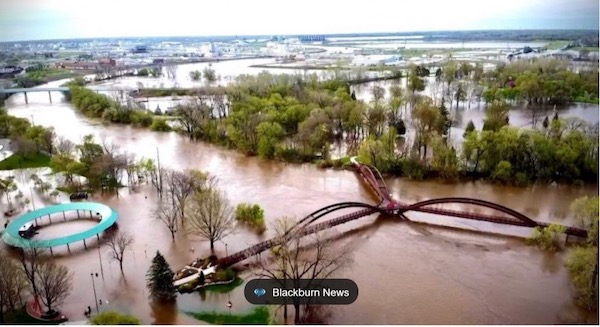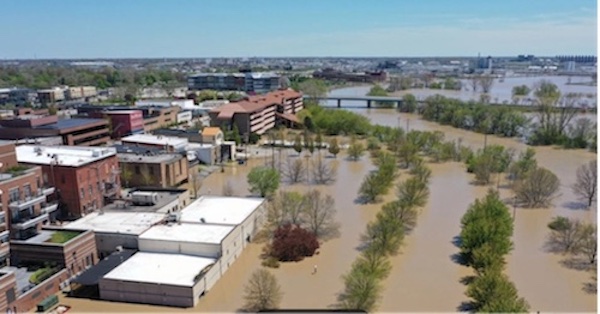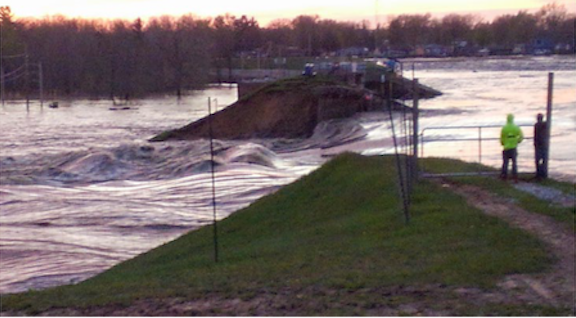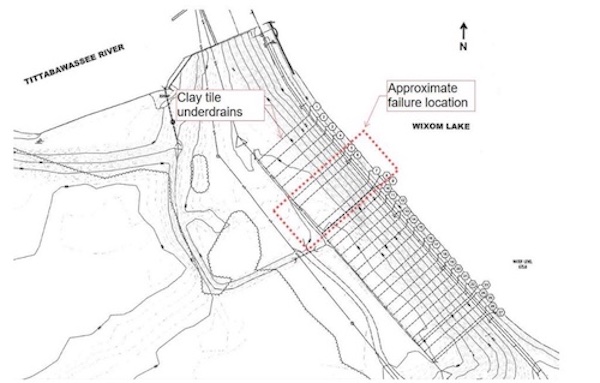RCA & FMEA TRAINING
Root Cause Analysis and Failure Modes & Effects Analysis training by Sologic provides the tools, skills, and knowledge necessary to solve complex problems and manage risk in any sector, within any discipline, and of any scale.Learn More
SOFTWARE
Sologic’s cloud-based Causelink has the right software product for you and your organization. Choose from Individual, Team, or Enterprise.Learn More
It has been 2 years since the catastrophic, sequential failures of the Edenville (Wixom Lake) and Sanford Lake dams on the Tittabawassee River system in central Michigan. These failures forced the evacuation of over 10,000 residents and resulted in damage to homes, businesses, and structures costing hundreds of millions of dollars. It was epic devastation that continues to affect families and the community to this day. Despite the historic damage, one very surprising aspect received little attention; there were no fatalities or serious injuries.
How could this be? Two major dams failed concurrently resulting in billions of gallons of water raging through four towns located downstream, with little warning. What happened here, or more importantly, what didn’t, deserves a deeper dive because it wasn’t merely ‘good luck’ that no one was hurt.

Tridge in Midland, Michigan
(Photo courtesy of Blackburn News, reprinted from www.cityofmidland.gov; May 20, 2020)
This event hit close to home, literally. Sologic’s main office in Midland is directly downstream of the Sanford dam. Fortunately, our office was spared, but others weren’t so lucky. Many lost their homes, businesses and material possessions in the throes of Covid when nothing in life was easy. Many also lost their household water supplies due to the immediate drop in the area water table. Both lakes remain drained to this day. (Sanford dam will be rebuilt and the lake level restored to normal by 2025. The Edenville dam will also be rebuilt, and the lake level restored by 2026 [1]).
You may recall videos showing homes, buildings, boats and even an actively discharging 500-gallon propane floating downstream after the dams failed. The debris field was incredible. But with such an incredible show of force, how is it that no one was seriously hurt? This is, perhaps, one of the most under-discussed aspects of this catastrophe yet likely one of the more valuable lessons to emerge. It turns out that the absence of serious injury was caused to happen.

Flooding of downtown Midland, Michigan
(Photo courtesy of thesailnews.com; June 2021)
So just what, exactly, did the Edenville, Sanford, Midland, Freeland and Saginaw communities and their respective Emergency Management teams do right such that no one perished or was seriously hurt?
First, an update on why the dams failed to begin with. The failure mode of the Edenville dam (located about 10 miles upstream of the Sanford dam) was different than that for the Sanford dam. A preliminary report [2], released in September 2021, attributed the failure of the Edenville dam to ‘liquefaction’ of the earthen dam, deep within its base. In other words, the underlying substrate at the bottom of the dam (primarily sand) became so saturated with water that it began to act like a thick liquid. Think ‘quicksand’. At that point, the lateral forces created by the high water level being held back overwhelmed the semi-fluid soil at the base of the dam, and it gave way.
The causes for the saturated dam substrate were: 1) High, pre-existing lake levels (heavy spring rains preceding the failures that raised the lake levels to their highest ever), 2) Original dam construction techniques that utilized porous materials for the structure, and 3) Inadequate weep tile drain system to sufficiently drain seepage from within the heart of the dam. There were other causes that contributed to the dam failure including insufficient spill-way size, limited weir capacity and inadequate dam maintenance.
While there were weep tiles (installed within the dam base) to drain ingress/seepage water, at the location of the failure, there were far fewer drain tiles as compared to the rest of the dam. (Figure 1

Edenville Dam Failure
(Photo courtesy of INDEPENDENT FORENSIC TEAM INTERIM REPORT on INVESTIGATION OF FAILURES OF EDENVILLE AND SANFORD DAMS; September 13, 2021)

Figure 1 - Edenville Dam drain tile locations
(image courtesy of INDEPENDENT FORENSIC TEAM INTERIM REPORT on INVESTIGATION OF FAILURES OF EDENVILLE AND SANFORD DAMS; September 13, 2021)
The failure mode of the Sanford dam was different from Edenville. The Sanford dam was smaller than Edenville. Like Edenville it was an earthen dam, but Sanford failed because of “over-topping” which caused rapid erosion of the earthen berm from the top down. Over-topping was caused by the upstream failure of the Edenville dam sending millions/billions of gallons of water downstream in a very short period of time.
Lets turn our attention to a positive in all this--no serious injuries or fatalities. Many chalk that up to ‘good luck’. I would disagree with that notion. While there are often causes that are not within our control, in almost all situations we can control some of the causes. In this case, I will focus on four of the causes that were controlled ahead of time that contributed to a safe outcome: 1) An effective Emergency Response plan, 2) An Emergency Response team that executed the emergency plan very well, 3) A communications system that sent clear, consistent and timely emergency messaging that effectively alerted the community, and 4) Community personnel that responded to the alerts and evacuation notices as intended. There are more positive causes, but these stand out.
Jenifier Boyer, Midland County Emergency Management Coordinator, sheds light on some of the reasons (i.e. causes) for the safe outcomes. One is that the Emergency Management team had previously evaluated different high-risk scenarios and created plans to mitigate or manage potential results (I.e: FMEA) . One of those scenarios was failure of the Edenville dam—a dam that had stood for almost 100 years. “Prior to 2020, the Midland County ER team developed an Edenville Dam Failure response plan. We planned for worst case scenario for roads/access, homes and businesses. By doing this, each agency/jurisdiction created a list of the areas they had responsibility over. Some of the agencies took planning a step further and identified priority tasks and how geographically they would need to breakup resources to accomplish the tasks. Some of this thinking was due to the lessons we learned in the 2017 flood event. By each agency having this knowledge, understanding and a plan, they knew before the failure what needed to be done. For example, we planned to lose every bridge across the Tittabawassee River (7 in Midland County), so we were able to close those bridges safely before we discovered the hard way the bridges were gone. “
Between 2017 (another major flood year) and 2019, Midland County Emergency Management worked with the dam owner/operator, Boyce Hydro, on updating their emergency action plans to better clarify terminology, roles and responsibilities. “A plan is not of great value if everyone that reads it, understands it differently. A plan should be written so that anyone can pick it up and understand what it’s communicating”, said Boyer.
Another positive cause was that multiple agencies practiced their plans. “Boyce Hydro held a series of emergency exercises in 2019 that reviewed the roles and responsibilities within their emergency plans as well as the County’s as we discussed a dam failure scenario” according to Jen. “The exercise revealed that the community response team would need to make critical decisions like evacuations before Boyce Hydro would reach that “condition” step in their response plan. Boyce Hydro’s role was solely focused on the operations of the dam and potential structural issues during an event. Community safety, warning, information, evacuations, etc. was all on the emergency response team. The actions that the emergency response team would need to make would take much longer to implement safely then what the timeline of the dam break analysis stated. Having this knowledge and understanding helped in making the decision to call for an evacuation prior to the communication from Boyce Hydro of a potential dam failure or a failure of the dam successful.”
Another cause for the lack of injuries was effective communications both internally within the emergency management team and with the community. “The warnings that we sent out used a relatively new system to us that we had never used before, WEA (Wireless Emergency Alerts)” according to Boyer. “WEA alerts is a system provided by the federal government to send emergency alerts across a community within a geographic area that reaches cell phones. Given this technology and enough time to go door to door for evacuations, we were able to have a high confidence that those that were in harm’s way directly downstream of the dam had received emergency notification of the situation. When the dam actually failed, we utilized the same WEA system for emergency alerts, as well as coordinated with the National Weather Service to issue a Flash Flood Warning for the Tittabawassee River. In addition to the WEA system, weather radio’s and local TV and radio stations were utilized. This was something that has never been done before. This allowed the community to get the same warning from multiple public safety agencies to communicate the life safety hazard of the current situation and to make sure the community knew this was the real deal”.
Another cause believed to contribute to the safe evacuation was a community with an inherent safety mindset. The Midland area is home to a major chemical manufacturing base for The Dow Chemical Company, DuPont, Corteva, Trinseo, Hemlock Semiconductor as well as a legacy Dow Corning manufacturing plant. Because of the risks in handling hazardous chemicals, safety is a top priority and it becomes engrained in employee’s thinking as well as those around them. It is estimated that 8,000 people in the Midland area work in support of chemical manufacturing businesses. If someone doesn’t work at Dow or Hemlock Semiconductor, they are certainly related to or know someone who does/did. As such, when the warnings to evacuate prior to, and as the dam’s failed, people responded accordingly.
I witnessed this firsthand because my wife and I were located halfway between Edenville and Sanford (picking up plants at a nursery) when the WEA alert went out that Edenville had failed. Everyone’s cell phone exploded at the same time. We were able to evacuate and cross the Tittabawassee River in Sanford about 5 minutes before the bridge was closed.
Midland County Emergency Management called for an evacuation a full 18 hours before the dam failed—an act that proved pivotal in avoiding injury. Even though some residents were allowed to reenter their properties after the initial evacuation (but prior to the failure) Jen believes their heightened sense of caution resulted in their immediate action to evacuate again when the second evacuation was called for when the Edenville dam failed.
There are learnings that can be extracted and leveraged in all incidents. In the world of root cause analysis, most calories are expended on reactively finding the causes of the incident/mishap. While the Edenville and Sanford dams were certainly tragedies, to not explore the positive causes of the safe outcome would be just as much a tragedy because it would be a missed opportunity to recognize the often thankless efforts by those to put solutions in place pre-emptively.
Usually, the world never learns about these types of proactive actions/solutions, and no hero cookies dispensed, when there are no tragedies. Fortunately in this case, FEMA took note and now uses the Edenville and Sanford dam failures as positive ‘lessons-learned’ to help other communities improve their emergency response plans.
In closing, I would like to personally say “Well Done!” to all of the surrounding county emergency management departments, with a special “Thank you” to Jenifier Boyer and the Midland County Emergency Management team for anticipating this event and proactively imbedding the solutions to the causes that prevented serious injury and fatality!
[1] Plan for the Restoration of the Four Lakes of Gladwin County and Midland County; Four Lakes Task Force, May 2021
[2] Investigation of Failures of Edenville and Sanford Dams; Independent Forensic Team Preliminary Report, September 13, 2021
RCA & FMEA TRAINING
Root Cause Analysis and Failure Modes & Effects Analysis training by Sologic provides the tools, skills, and knowledge necessary to solve complex problems and manage risk in any sector, within any discipline, and of any scale.Learn More
SOFTWARE
Sologic’s cloud-based Causelink has the right software product for you and your organization. Choose from Individual, Team, or Enterprise.Learn More